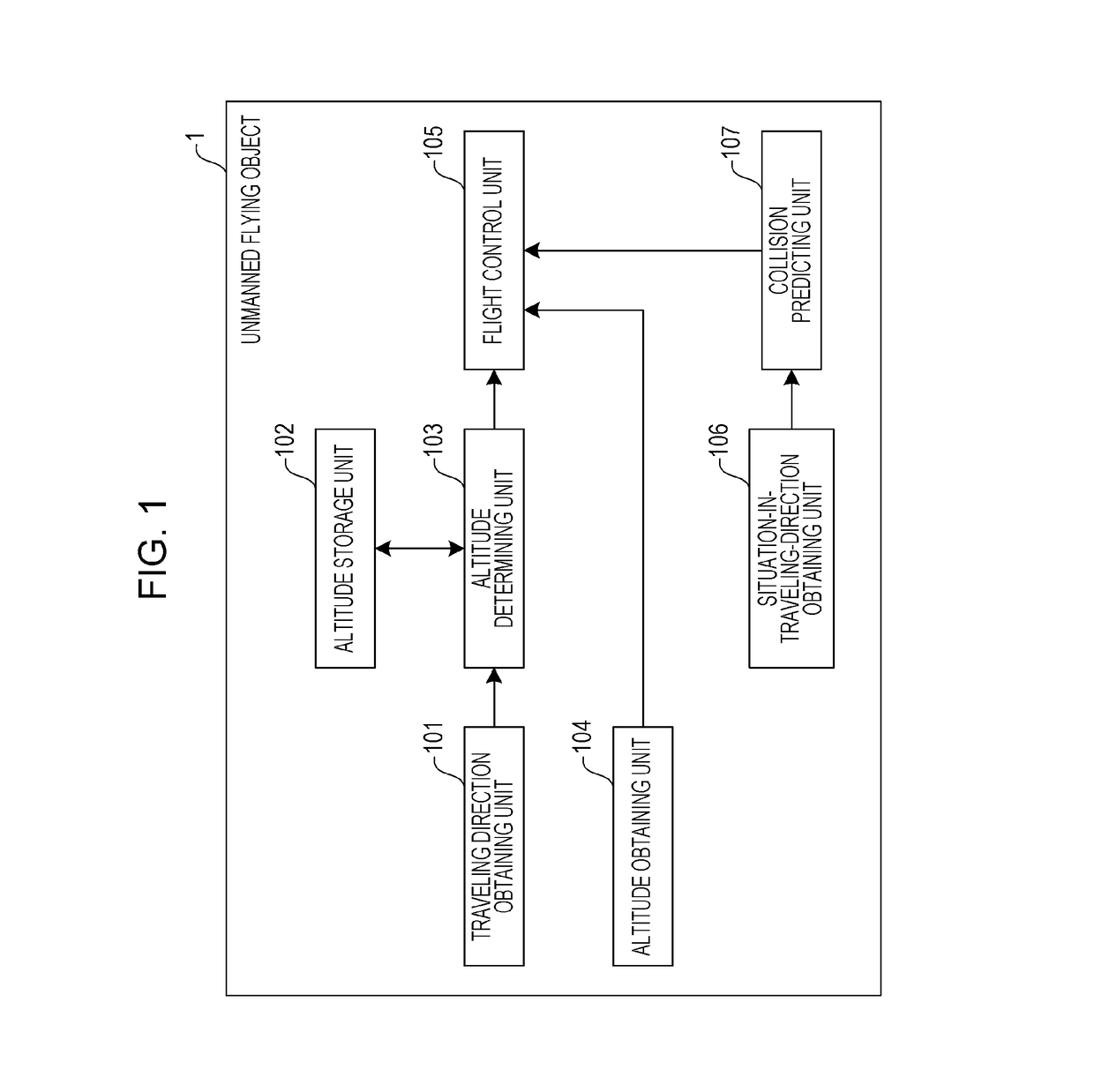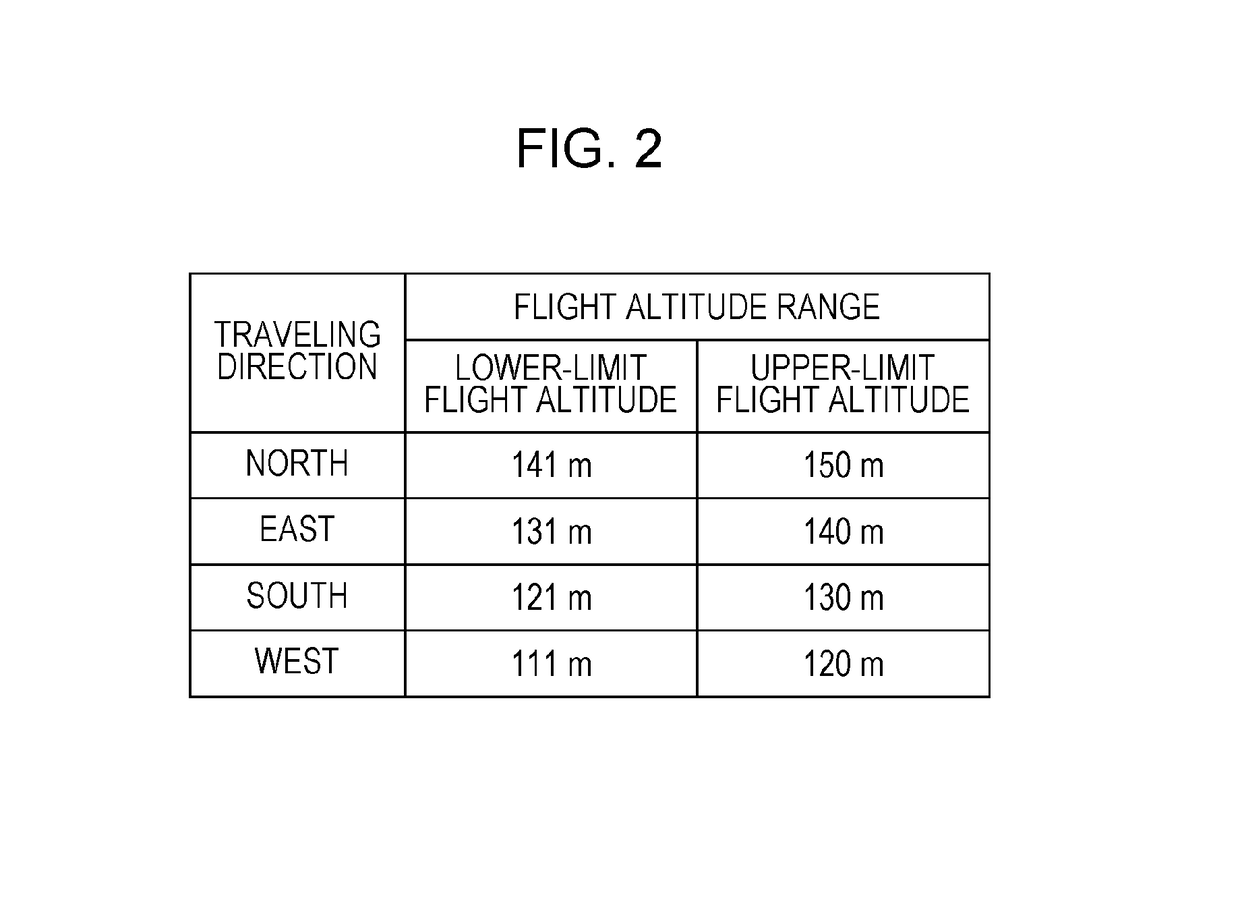Flight control method and unmanned unmannered aerial vehicle
a technology of flight control and unmanned aerial vehicles, applied in the direction of process and machine control, using reradiation, instruments, etc., can solve the problems of increasing the chance and the foregoing technique is susceptible to further improvement, so as to achieve the effect of reducing the risk of collision between unmanned aerial vehicles
- Summary
- Abstract
- Description
- Claims
- Application Information
AI Technical Summary
Benefits of technology
Problems solved by technology
Method used
Image
Examples
first embodiment
[0048]FIG. 1 is a diagram illustrating the configuration of an unmanned aerial vehicle according to a first embodiment of the present disclosure.
[0049]An unmanned aerial vehicle 1 flies autonomously in accordance with a flight route generated in advance. The unmanned aerial vehicle 1 is equipped with a plurality of propellers and moves forward, backward, leftward, rightward, upward, and downward, with the rotation rate of each propeller being controlled. The unmanned aerial vehicle 1 flies autonomously along a flight route generated in advance while obtaining its current position by using the Global Positioning System (GPS), which is not illustrated. The flight route is generated by a flight route generation apparatus, for example, a smartphone, a tablet computer, or a personal computer. The unmanned aerial vehicle 1 receives the flight route generated by the flight route generation apparatus.
[0050]The unmanned aerial vehicle 1 illustrated in FIG. 1 includes a traveling direction ob...
second embodiment
[0086]Next, a description will be given of an unmanned aerial vehicle according to a second embodiment of the present disclosure. An unmanned aerial vehicle is susceptible to wind when the weight of its body is low. Accordingly, in the second embodiment, a flight altitude range is changed in accordance with the weight of an unmanned aerial vehicle.
[0087]FIG. 5 is a diagram illustrating the configuration of an unmanned aerial vehicle according to the second embodiment of the present disclosure. The unmanned aerial vehicle 11 illustrated in FIG. 5 includes a traveling direction obtaining unit 101, an altitude storage unit 102, an altitude obtaining unit 104, a flight control unit 105, a situation-in-traveling-direction obtaining unit 106, a collision predicting unit 107, a weight obtaining unit 108, and an altitude determining unit 1031. In the unmanned aerial vehicle 11 according to the second embodiment, the same components as those in the unmanned aerial vehicle 1 according to the ...
third embodiment
[0101]Next, a description will be given of an unmanned aerial vehicle according to a third embodiment of the present disclosure. If there is a tall structure such as a building around an unmanned aerial vehicle and if the unmanned aerial vehicle flies low, the chance of a collision between the unmanned aerial vehicle and the structure is increased. Accordingly, in the third embodiment, a flight altitude range is changed in accordance with the height of a structure around a current position of an unmanned aerial vehicle.
[0102]FIG. 7 is a diagram illustrating the configuration of an unmanned aerial vehicle according to the third embodiment of the present disclosure. The unmanned aerial vehicle 12 illustrated in FIG. 7 includes a traveling direction obtaining unit 101, an altitude storage unit 102, an altitude obtaining unit 104, a flight control unit 105, a situation-in-traveling-direction obtaining unit 106, a collision predicting unit 107, a structure information obtaining unit 109,...
PUM
 Login to View More
Login to View More Abstract
Description
Claims
Application Information
 Login to View More
Login to View More - R&D
- Intellectual Property
- Life Sciences
- Materials
- Tech Scout
- Unparalleled Data Quality
- Higher Quality Content
- 60% Fewer Hallucinations
Browse by: Latest US Patents, China's latest patents, Technical Efficacy Thesaurus, Application Domain, Technology Topic, Popular Technical Reports.
© 2025 PatSnap. All rights reserved.Legal|Privacy policy|Modern Slavery Act Transparency Statement|Sitemap|About US| Contact US: help@patsnap.com



